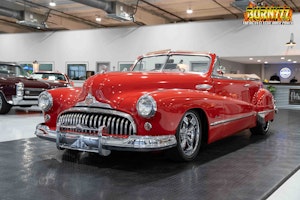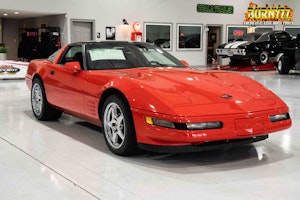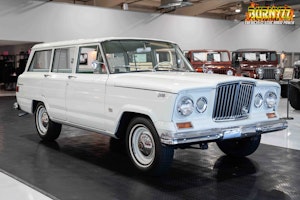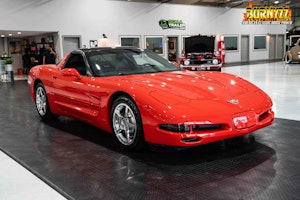Media | Articles
8 Corvette(ish) concepts you may or may not know
Pull a thread on a sweater, and you may reduce it to a ball of yarn. When trying to unravel automotive history, you also sometimes end up with a yarn or two. Here’s an example: Perhaps because it was the only show car in the history of General Motors’ Motorama that actually became a car you could buy in showrooms, the Corvette earned such positive reception from the public that GM executives decided to green-light the concept. That legend is likely not true, at least the part about why the Corvette was approved for production.
Here’s the real story. Chevrolet brand manager Thomas Keating wanted a product to compete with the British sports cars, which had become popular in America following WWII thanks to GIs returning from the UK and Europe. The two-seat, rear-drive, open-top Vette certainly got a strong reception. A true part of Corvette lore concerns an attendee at New York’s Waldorf Astoria, where GM first showed the car, who was so impressed by the car’s potential and disappointed in its driveline (a six-cylinder engine and two-speed automatic transmission) that he wrote a letter to Chevrolet’s head engineer, Ed Cole, who hired the young engineer. His name was Zora Arkus Duntov, and he went on to become the Corvette’s chief engineer for decades.
Since that first Corvette show car (EX-52), concepts have played an important role in the history of the brand, shaping both production models and brand enthusiasm. To Corvette enthusiasts, Bill Mitchell’s 1959 Stingray and the Mako Shark II are almost as familiar as the Split Window or the C3. In my exploration of the mid-engine, all-wheel drive Corvette concepts that preceded the new, hybrid/AWD E-Ray, I came across a number of Corvette concepts that are worthy of attention. Some are better known than others, and not all of them are precisely Corvettes, but all of them had some kind of role in shaping the brand.
The Duntov Mule
First, let’s get back to Zora. After he was hired on at GM, he wrote a four-page memo encouraging his superiors to make cars that would appeal to the hot-rodders of his day. It was Duntov who convinced Cole to take the small-block, overhead-valve V-8 in development for Chevy sedans and put it into the Corvette, turning the two-seater into a true performance car. The result was EX-87, currently owned by Ken Lingenfelter and better known as the Duntov Mule.
Not only is EX-87 literally the first Corvette with a V-8 engine, but it also has a provenance and pedigree that is a bit hard to believe. The engineer tasked with installing that engine in a production ’54 chassis was three-time Indy 500 winner Mauri Rose. The famed operator of Daytona’s “Best Damn Garage in Town,” Smokey Yunick, was responsible for tuning the V-8 prototype. Duntov set speed records in it. The cut-down windshield, tonneau cover over the passenger seat, and tail fin (for high-speed stability) were also Duntov’s ideas, as was increasing the displacement of the engine from 265 to 307 cubic inches.
1961 Mako Shark I

If you’re wondering why the Corvette was nicknamed Stingray, that’s because Bill Mitchell, who followed Harley Earl as GM’s head of styling, liked to go deep-sea fishing. He followed up 1959’s Stingray racer and show car with XP-755, the original Mako Shark.
Not as well known today as the Mako Shark II, which presaged the production version of the third-gen, or C3, Corvette (1968–82), the first Mako Shark was based on the second-gen car (C2). It had a streamlined front end that came to a point, six taillights, and an impressive paint job that faded, roof to rocker panels, from blue to white. The color scheme reproduced the coloration of the actual mako shark, an example of which was displayed by Mitchell in his office.
The way the story goes, when the styling team repeatedly failed to paint-match the shark’s colors to Mitchell’s satisfaction, they snuck into his office one night and repainted the fish to match the car.
1962 Corvair Monza GT
Yes, the Monza GT was branded as a Corvair concept and used an engine (an air-cooled, horizontally opposed turbocharged six-cylinder) from the production car—mounted in the middle, not the back, of the chassis. However, XP-777 and its open-roof sibling Monza SS, designed by Larry Shinoda and Tony Lapine, may have been the first expression of the styling themes expressed in Mako Shark II and the third-generation Corvette. The chassis for the Monza GT was also the basis for the 1963 Corvette GS-II, also penned by Shinoda, and part of the Corvette Grand Sport racing program. While the GS-II never raced, it became the basis for Jim Hall’s Chaparral 2C racer.
1967 Astro I

For 1967 Larry Shinoda took the design themes of the Monza GT and Monza SS to a radical extreme with the extremely low Astro I, also based on a Corvair. At just 35.5 inches tall, it is even lower than the Ford GT40. GM’s official history of the car says that it was “designed to investigate the visual potential of automobile aerodynamic characteristics” and that it “dramatically demonstrated the harmony that could be achieved between aesthetics and aerodynamics.”
With a roofline that low, ingress via conventional door was problematic, so roof and side glass were integrated into a clamshell that tilted rearward. To save driver and passenger from plopping down into such low seats, the chairs automatically raised when the canopy was opened and lowered as it retracted. Chevrolet said that the Astro I was powered by an experimental, overhead-cam version of the Corvair six-cylinder, but it’s not clear whether that engine was actually ever fitted to the Astro I.
1969 Manta Ray
I’d like to show you a photo of what the 1965 Mako Shark II, XP-830, looks like today but that influential Corvette concept, also designed by Larry Shinoda, no longer exists—at least under that name.
For the 1969 Detroit Auto Show, Mitchell’s team modified the Mako Shark II into the Manta Ray concept, expanding the Corvette’s aquatic menagerie. The Manta Ray had a longtail rear end, a styling feature that would show up in the Aerovette family of concepts (we’ll get to those in a bit), a “sugar scoop” rear glass treatment, a flip-up roof panel, tiny side mirrors, pop-up turn signal lights, a deep front spoiler, and side exhaust pipes—the last perhaps intended as a nod to the original 1959 Stingray. The Manta Ray was powered by the aluminum-block ZL-1 engine developed by Chevrolet with Bruce McLaren for use in the Can-Am racing series.

In a bit of concept-car trivia, the Manta Ray Corvette was not the first Manta Ray car. In 1951, a couple of West Coast customizers, Glen Hire and Vernon Antoine, built a highly modified Studebaker called the Manta Ray that bears more than a little resemblance to Harley Earl’s famous LeSabre concept.
1973 Aerovette

One of the better-known Corvette concepts that never reached production is the Aerovette. Its origins lie in the XP-880 mid-engined Astro II concept, first revealed at the 1968 New York Auto Show. Less extreme than the Astro I, the Aerovette had actual doors, a front storage hold, and a clamshell-style rear end that lifted to allow access to the transversely mounted V-8 engine.
Duntov’s team then developed two prototypes for what was tagged XP-882. Chevy general manager John DeLorean initially canceled the program, deeming it too costly, but when Ford announced the DeTomaso Pantera would be sold at its Lincoln-Mercury dealers, the program was revived and one of the XP-882s displayed at the 1970 New York show.

At the same time, General Motors was developing its own version of the rotary Wankel engine for the Vega small car. In 1972, DeLorean approved additional development of the XP-882 chassis, leading to the XP-895, powered by a pair of the two-rotor Wankels ganged together to make a 420-hp, four-rotor powerplant. A sibling, two-rotor car dubbed XP-897 was also developed. Both of those concepts were shown in 1973, before the oil crisis sparked by the Yom Kippur War and increasingly stringent emissions regulations put the kibosh on rotaries, which are relatively thirsty and dirty.

The exterior styling of the rotary-powered Corvette concepts was much rounder and organic than the production Corvette of the era. The two cars wore distinctive fender flares and NACA ducts on their hoods.
Three years later, in 1976, the four-rotor engine in XP-895 was swapped out for a 400 cubic-inch V-8. The car was renamed Aerovette and, according to reports, it was approved for production for the 1980 model year, albeit with a 350-cubic-inch small-block Chevy V-8.
By 1976, John DeLorean had moved on to his own self-named venture. It may be just a coincidence that, like the Delorean DMC-12, the Aerovette was given gullwing doors. Unfortunately for Corvette fans hoping for the new design, all advocates for producing the Aerovette (Duntov, Mitchell, Ed Cole) had retired by then, and new Corvette chief Dave McLellan, after deciding that the conventional front-engine layout was more economical and would have better performance than the Aerovette, killed that program.
Reynolds Aluminum Corvette

The reason why the Aerovette had poorer performance was that, unlike the production Corvette with a composite body, the Aerovette’s skin was steel, making it 100 pounds heavier than a 1973 Corvette coupe. DeLorean, who then was still at GM, turned to Reynolds Metals.
Reynolds, the same folks who make aluminum foil used in kitchens, had been a GM supplier for over a decade, providing the alloy used in Corvair engines, Corvette intake manifolds, bell housings, and other parts, along with the specialty alloy used in the ZL1 block, L88 head, and all-aluminum Vega motors. Reynolds made an exact copy of XP-895 out of 2036-T4 aluminum, a special alloy that could be spot-welded. Even then, some epoxy adhesive was used to make the hand-fabricated body. The result shaved 450 pounds off the weight, making the body almost 40 percent lighter. While it weighed significantly less, it was also significantly more expensive to produce than either a steel or composite body.
2009 Stingray concept
The most recent Corvette concept was the 2009 Stingray, intended to preview the seventh-generation Corvette, which was introduced in 2013. Interestingly, it may be the least well-known of the Corvette concepts here. Given the design brief of making a retro-modern Corvette, the Stingray, which also had a starring role as an Autobot in one of the Transformer movies, mashed up the split rear window of the ’63 C2 with contemporary scissor doors and a clamshell hood. Although the Stingray was part of the C7’s development, it also anticipated the newest C8 Corvette, the E-Ray, in that it was a mild-hybrid.
If you had to pick one, which one of these concepts would you tell Chevy to put into production? Drop a comment below.
***
Marketplace
Buy and sell classics with confidence
Check out the Hagerty Media homepage so you don’t miss a single story, or better yet, bookmark it. To get our best stories delivered right to your inbox, subscribe to our newsletters.

















































































































































Hard to discuss Corvette prototypes – especially the mid-engine variety – without mentioning XP-819. Another Shinoda design, slotting between the Monza and ‘67 Astro, it was possibly the first mid-engine (or more accurately rear-engine) Corvette prototype designed with an eye towards production.
While not my favorite Shinoda design, given the design brief he received of wrapping the massive V-8 in the tail of the car with “something beautiful”, I think he succeeded…and certainly showed what he had on his mind for the soon to come C3.
The aluminum ZL1 was deveoped originally with Jim Hall and his Chaparral 2G during the 67′ Can-Am season.
The engine had many development teething problems and was an embarassing oil leaker. The problems were solved for the 68′ season and they were first ordered by Penske (engines shipped to Traco) and then ordered by McLaren. The engines were then made available to everyone after Hall did the development work with Chevrolet during the 67′ season, while the other teams were using the reliable small block V8.
The 2009 sting ray . Split windows rock.